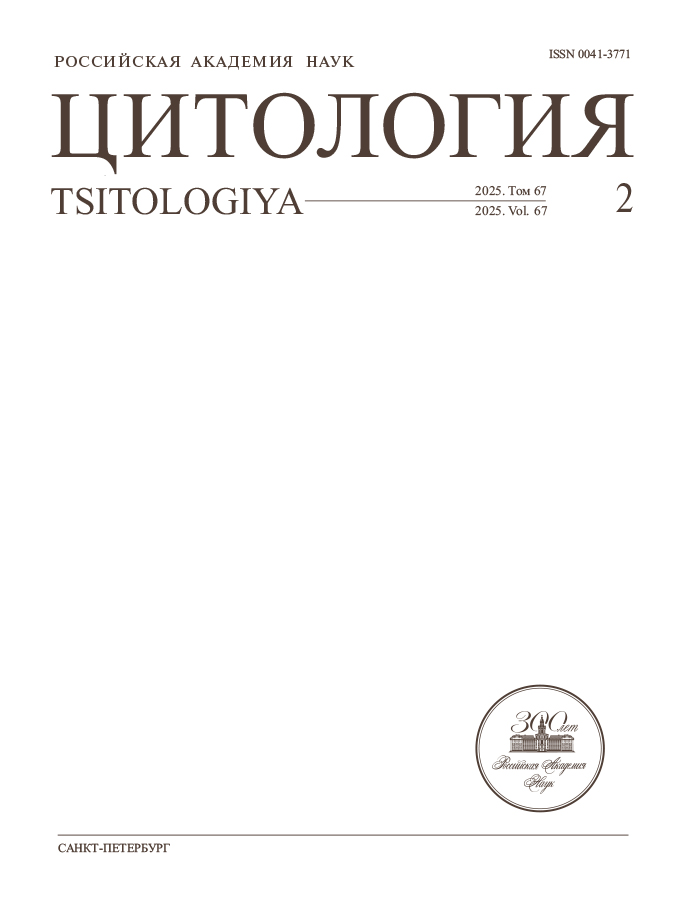Активация адгезивных свойств клеток меланомы в условиях 3d-культивирования
- Авторы: Черных Д.В.1, Зинченко И.С.1, Рукша Т.Г.1
-
Учреждения:
- Красноярский государственный медицинский университет им. проф. В.Ф. Войно-Ясенецкого, кафедра патологической физиологии
- Выпуск: Том 66, № 4 (2024)
- Страницы: 330-340
- Раздел: Статьи
- URL: https://rjonco.com/0041-3771/article/view/669498
- DOI: https://doi.org/10.31857/S0041377124040025
- EDN: https://elibrary.ru/QDCKFT
- ID: 669498
Цитировать
Полный текст
Аннотация
В настоящей работе на модели меланомы оценивали жизнеспособность и адгезивные свойства клеток линий BRO и SK-MEL-2. Показано, что в клетках линии BRO развитие апоптоза после воздействия дакарбазином сочеталось с переходом доли клеток в фазу G0 клеточного цикла, что подтверждает ранее полученные результаты. В клетках меланомы SK-MEL-2 наблюдали отсутствие апоптоза в 3D-сфероидах и отсутствие выхода из клеточного цикла. Также выявлено, что в контрольных сфероидах (клетки без воздействия) линий меланомы BRO и SK-MEL-2 адгезия к фибронектину была выше по сравнению с клетками монослоя контроля, что объясняется трехмерной структурой, требующей коммуникации клеток с внеклеточным матриксом. В сфероидах, сформированных клетками SK-MEL-2, дакарбазин индуцировал снижение адгезии к фибронектину, что может быть связано с развитием лекарственной устойчивости. После воздействия дакарбазином повышаются уровни экспрессии интегринов αV и β8 в клетках BRO и SK-MEL-2, а также интегрина β5 в клетках SK-MEL-2, что может указывать на участие этих молекул в утрате пролиферативного статуса опухолевых клеток.
Ключевые слова
Полный текст
Об авторах
Д. В. Черных
Красноярский государственный медицинский университет им. проф. В.Ф. Войно-Ясенецкого, кафедра патологической физиологии
Автор, ответственный за переписку.
Email: tatyana_ruksha@mail.ru
Россия, Красноярск
И. С. Зинченко
Красноярский государственный медицинский университет им. проф. В.Ф. Войно-Ясенецкого, кафедра патологической физиологии
Email: tatyana_ruksha@mail.ru
Россия, Красноярск
Т. Г. Рукша
Красноярский государственный медицинский университет им. проф. В.Ф. Войно-Ясенецкого, кафедра патологической физиологии
Email: tatyana_ruksha@mail.ru
Россия, Красноярск
Список литературы
- Achill T. M., Meye J., & Morgan J. R. 2012. Advances in the formation, use and understanding of multi-cellular spheroids. Exp. Op. Biol. Ther. V. 12. P. 1347. https://doi.org/10.1517/14712598.2012.707181
- Aksenenko M.B., Palkina N.V., Sergeeva O.N., Sergeeva E. Yu., Kirichenko A.K., Ruksha T.G. 2019. miR-155 overexpression is followed by downregulation of its target gene, NFE2L2, and altered pattern of VEGFA expression in the liver of melanoma B16-bearing mice at the premetastatic stage. Int. J. Exp. Pathol. V. 100. P. 311. https://doi.org/10.1111/iep.12342
- Azimian-Zavareh V., Dehghani-Ghobadi Z., Ebrahimi M., Mirzazadeh K., Nazarenko I., Hossein G. 2021. Wnt5A modulates integrin expression in a receptor-dependent manner in ovarian cancer cells. Sci. Rep. V. 11. P. 5885. doi: 10.1038/s41598-021-85356-6
- Chen G., Kawazoe N., Tateishi T. 2008. Effects of ECM proteins and cationic polymers on the adhesion and proliferation of rat islet cells. The Open Biotechnol. J. V. 2: e1874070727154. https://doi.org/10.2174/1874070700802010133
- Colella G., Fazioli F., Gallo M., De Chiara A., Apice G., Ruosi C., Cimmino A., De Nigris F. 2018. Sarcoma spheroids and organoids — promising tools in the era of personalized medicine. Int. J. Mol. Sci. V. 19. P. 615. https://doi.org/10.3390/ijms19020615
- Esimbekova A.R., Palkina N.V., Zinchenko I.S., Belenyuk V.D., Savchenko A.A., Sergeeva E.Y., Ruksha T.G. 2023. Focal adhesion alterations in G0-positivemelanoma cells. Cancer Med. V. 12. P. 7294. https://doi.org/10.1002/cam4.5510
- Kewitz S., Stiefel M., Kramm C.M., & Staege M.S. 2014. Impact of O6-methylguanine-DNA methyltransferase (MGMT) promoter methylation and MGMT expression on dacarbazine resistance of Hodgkin’s lymphoma cells. Leukemia research. V. 38. P. 138. https://doi.org/10.1016/j.leukres.2013.11.001
- Komina A.V., Palkina N.V., Aksenenko M.B., Lavrentev S.N., Moshev A.V., Savchenko A.A., Averchuk A.S., Rybnikov Y.A., Ruksha T.G.2019.Semaphorin-5A downregulation is associated with enhanced migration and invasion of BRAF-positive melanoma cells under vemurafenib treatment in melanomas with heterogeneous BRAF status. Melanoma Res. V. 29. P. 544. https://doi.org/10.1097/CMR.0000000000000621
- Lee S. Y., Koo I. S., Hwang H. J., Lee D. W. 2023. In vitro three-dimensional (3D) cell culture tools for spheroid and organoid models. SLAS Discov. V. 29. P. 5 131. https://doi.org/10.1016/j.slasd.2023.03.006
- Lin T. C., Yang C. H., Cheng L. H., Chang W. T., Lin Y. R., Cheng H.C. 2019. Fibronectin in cancer: friend or foe. Cells. V. 9. P. 27. doi: 10.3390/cells9010027.
- Livak K. J., Schmittgen T. D. 2001. Analysis of relative gene expression data using real-time quantitative PCR and the 2-ΔΔCT method. Methods. V. 25. P. 402. https://doi.org/10.1006/meth.2001.1262
- Liu Y., Sheikh M. S. 2014. Melanoma: molecular pathogenesis and therapeutic management. Mol. Cell.Pharmacol. V. 6. P. 228.
- Sakalem M. E., De Sibio M. T., da Costa F. A. D. S., de Oliveira M. 2021. Historical evolution of spheroids and organoids, and possibilities of use in life sciences and medicine. Biotechnol. J. V. 16: 2000463. https://doi.org/10.1002/biot.202000463
- Srisongkram T., Weerapreeyakul N., Thumanu K. 2020. Evaluation of melanoma (SK-MEL-2) cell growth between three-dimensional (3D) and two-dimensional (2D) cell cultures with fourier transform infrared (FTIR) microspectroscopy. Int. J. Mol. Sci. V. 21: 4141. https://doi.org/10.3390/ijms21114141
- Syed A. M., Kundu S., Ram C., Kulhari U., Kumar A., Mugale M. N., Murty U.S., Sahu B. D. 2022. Aloin alleviates pathological cardiac hypertrophy via modulation of the oxidative and fibrotic response. Life Sci., V. 288: 120159. https://doi.org/10.1016/j.lfs.2021.120159
- Zanoni M., Cortesi M., Zamagni A., Arienti C., Pignatta S., Tesei A. 2020. Modeling neoplastic disease with spheroids and organoids. J. Hematol. Oncol. V. 13. P. 1. https://doi.org/10.1186/s13045-020-00931-0
- Zanoni M., Piccinini F., Arienti C., Zamagni A., Santi S., Polico R., Bevilacqua A., Tesei A. 2016. 3D tumor spheroid models for in vitro therapeutic screening: a systematic approach to enhance the biological relevance of data obtained. Sci. Rep. V. 6: 19103. https://doi.org/10.1038/srep19103
- Zhou J., Yi Q., Tang L. 2019. The roles of nuclear focal adhesion kinase (FAK) on cancer: a focused review. J. Exp. Clin. Cancer Res. V. 38. P. 250. https://doi: 10.1186/s13046-019-1265-1
- Wu C., Weis S. M., Cheresh D. A. 2023. Upregulation of fibronectin and its integrin receptors – an adaptation to isolation stress that facilitates tumor initiation. J. Cell Sci. V. 136: 261483. https://doi.org/10.1242/jcs.261483
Дополнительные файлы


















